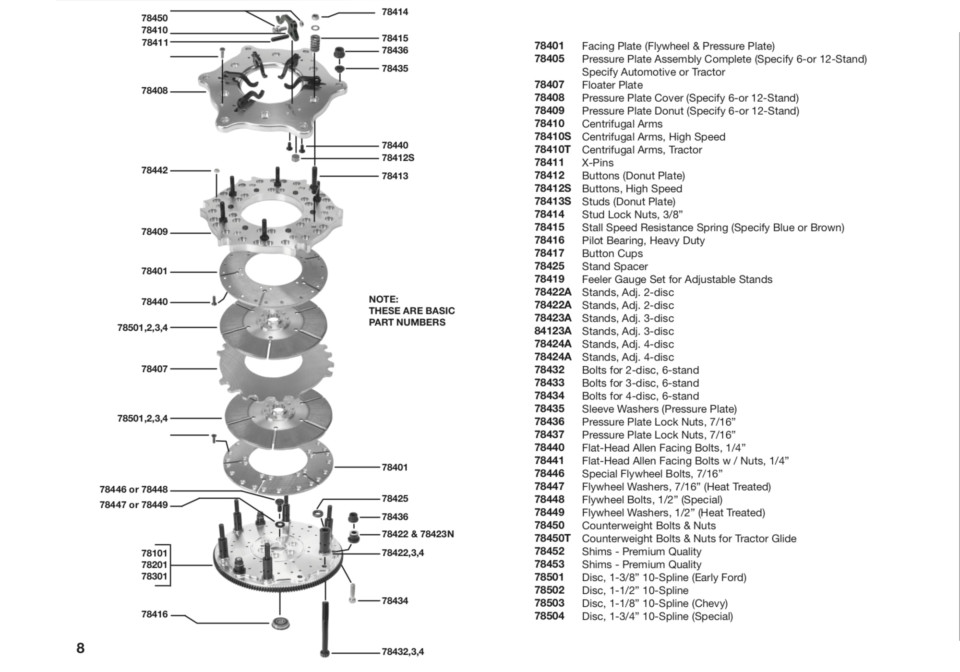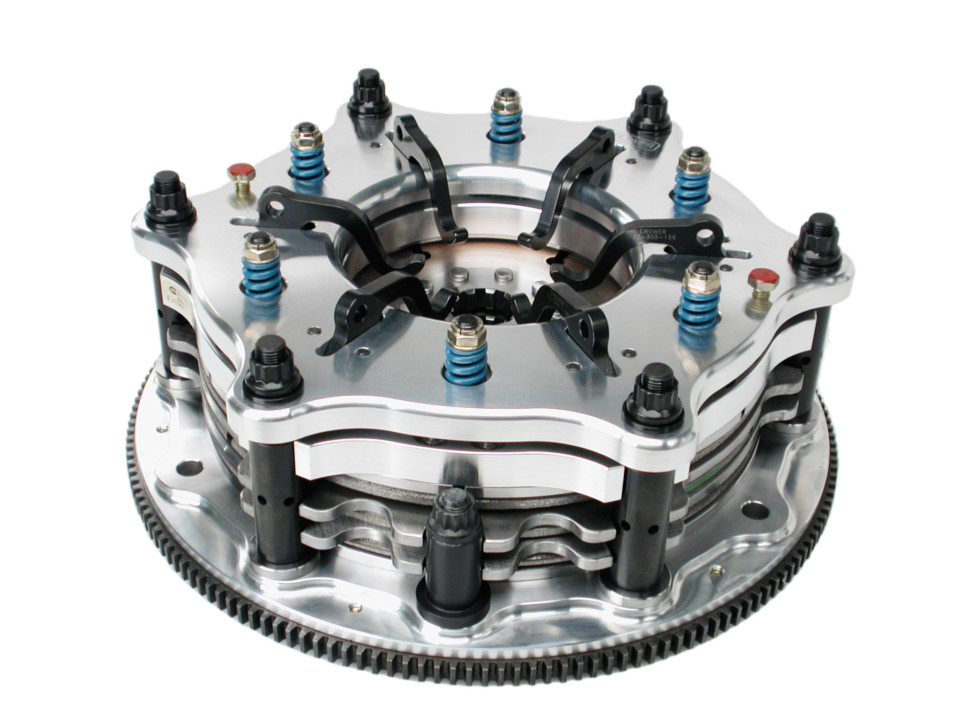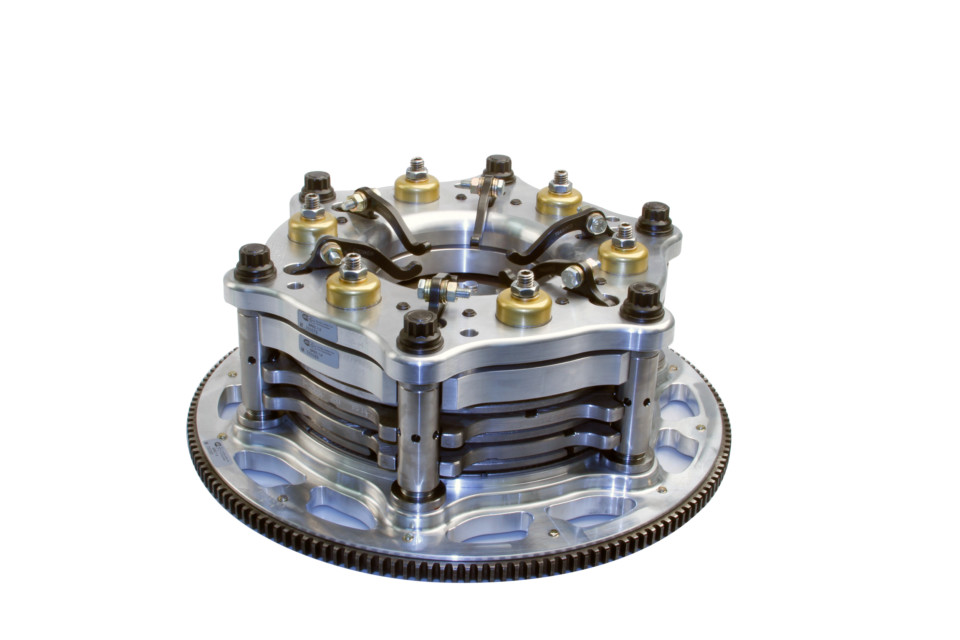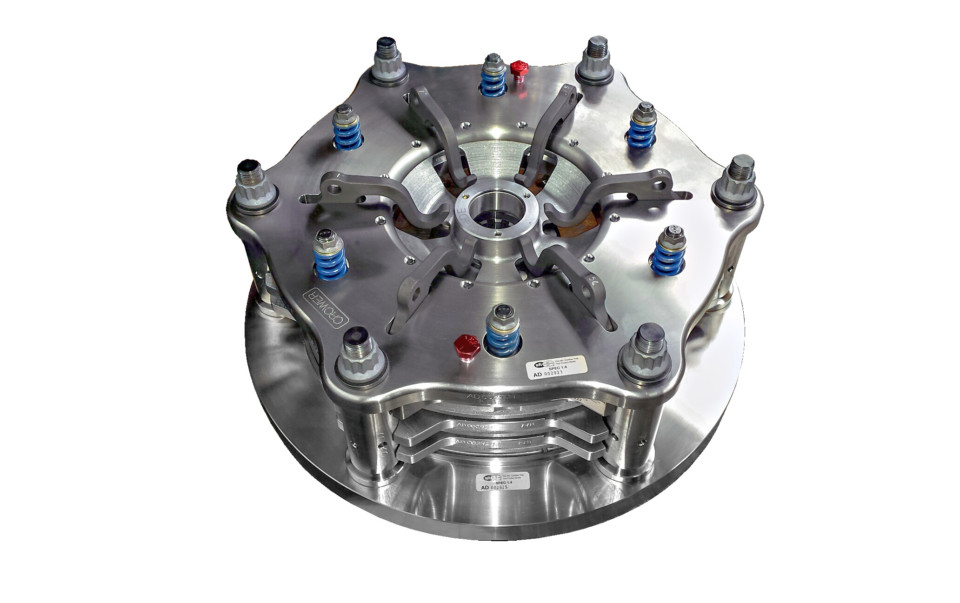Part 2
How Does It Work?
Like a pedal-operated clutch, the Crowerglide has a flywheel with six stands that hold in place a series of plates and discs: first is the Facing Plate, followed by a disc, a floater plate, a second disc, a second Facing Plate, the Pressure Plate Donut, and the Pressure Plate cover (in that order in a two-disc configuration).

An exploded diagram of a two-disc Crowerglide.
The Pressure Plate cover is bolted to the stands and the donut hangs beneath it on a series of six springs. The arms, situated in that gap, oppose the forces of the springs, prying the donut down against the spring pressure. To simplify, the springs try to hold it back by maintaining the air gap between the plates and discs, and the arms work to push it down. The clutch can be adjusted by adding weights to the arms, which will make the stall speed go down — meaning the arms will have more power to overcome the springs. If you decrease weight on the arms or tighten the stall springs, the stall speed increases.
“You just give it throttle; all it knows is RPM, and as the engine RPM goes up, it throws the arms out and they put pressure on the donut, which closes up an air gap in the clutch,” Levine explains. “So when you start the car up and run it at an idle, it’s basically slipping, and then as you bring the engine up, that pack tightens up. It’s often also called a slipper clutch, because we use a compound on the discs that slips, because it’s made out of graphite and various materials that are designed to make it slip but fully lock up. In a lot of cases these cars with a pedal clutch or automatic clutch never fully lock up when they’re going through the lights. It’s trying to, but ideally it might be slipping 50 RPM, which is really nothing.”

According to Levine, once racers get the clutch set to where it’s operating as intended, they’ll tune it by using a feeler gauge to adjust the air gap in the pack (the plate and floater assembly).
“In nitro drag racing, opening up the gap allows the motor to get a slight run at the clutch so it’ll strike the tire harder. An A/Fuel car might be .40-.50-inches, which is pretty tight. If you have a car that likes .40 and you open it up to .45, it might blow the tires off right at the hit. That’s how effective it is. And once an A/Fuel car gets the right amount of counterweight, they can almost leave it alone. So what effects how the clutch works is the radius on the arm — a bigger radius gives the arm more advantage — the air gap, and the spring tension.”
If the effective stall speed is set too low, as you may surmise, it’ll engage at the hit and drag the engine RPM down, possibly never allowing it into its powerband and robbing the car of performance. This will also inhibit the engine from reaching an RPM to lock the clutch up during the run. Nevermind the effect that dragging the engine down has on fuel pressure, which could cause a host of other problems to the engine internals.
Naturally, in order to rev the engine at the line, in the fashion of a blown Top Alcohol Dragster or Funny Car, the Crowerglide would need to be set up to do so — otherwise the rise in engine RPM would simply drag the car off the line, even with the brakes applied. The spring pressure would have to be tighter, they’d potentially have to use the pedal, and as Levine points out, would simply take away the advantage that an automatic clutch provides.
“Alcohol cars used to do it — they’d run it a couple of ways: leaving from an idle, and leaving from sub-stall, where they’d bring the idle up with the pedal, but not hitting stall, so that it’s closer to reaching the point it hits stall,” Levine shares.
[QUOTE]…what effects how the clutch works is the radius on the arm — a bigger radius gives the arm more advantage — the air gap, and the spring tension. – Roger Levine, Crower
While the clutch operates by RPM, that doesn’t mean there isn’t a clutch pedal or input from the driver, and Levine suggests everyone using a Crowerglide have one for certain scenarios.
“You can do things with the clutch pedal you can’t do without,” he explains. “Let’s say you do a burnout and it’s dragging and you can’t get it into reverse … the arms might be hanging up slightly. A dab of the clutch pedal against the fingers can put them back to their neutral position (where they sit when it’s not turning or barely turning).”
However, on the starting line they are purely brake and throttle, not unlike a junior dragster with a Salsbury-style clutch.

No different than a pedal clutch, the use of both larger diameter discs and floaters, and the addition of more discs are integral as you climb the horsepower ladder.
Per Levine, a 10-inch, big-stand, three-disc is most common in nostalgia fuel racing: the larger the disc the more torque capacity. there is. Likewise, additional discs coincide with ever-higher horsepower engines. “There are certain classes where a certain thing is the norm, like a three-disc in a nostalgia Funny Car. There are a few guys trying two-disc in nostalgia Top Fuelers, since they’re lighter cars. NHRA A/Fuel dragsters typically use four discs, nostalgia A/Fuelers three.”
Versus A Pedal-Operated Clutch
As with anything there are tradeoffs, and the pedal-clutch versus the automatic is no exception.
The plus is that an automatic clutch, as noted previously, will repeat the same pass after pass. Levine says it’s also a little smoother, as well, because one can get overzealous with a pedal clutch adding too much counterweight on the arms and go into tire-shake — especially if it doesn’t have enough base pressure screwed into it. “With a pedal clutch there’s a balance between spring pressure (which adds to the clutch versus subtracting from it) and counterweight to control the initial engine RPM and get the tires moving. Then as you sidestep the clutch, if there isn’t enough spring there and then you try to make it up with counterweight, it’ll pull the motor down and it’ll shake. That drops the RPM and in turn lowers the fuel pressure. If it zips through the base pressure and goes higher than it was intended to, it’s going to hit those arms and bring the engine to reality.”
